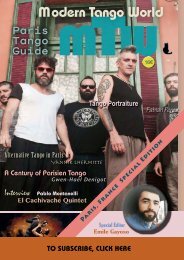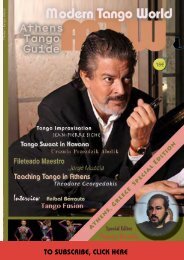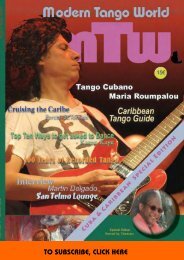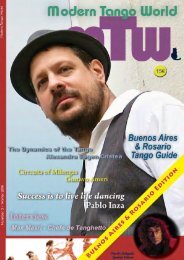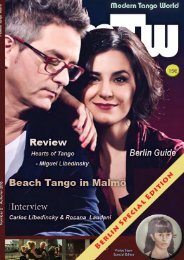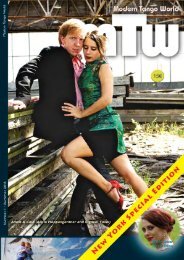Modern Tango World #8 (Moscow)
Moscow Special Features Magnolias on the Snow Andrey Klimovich 03 Milonga Chique Evgeny Morozow 10 The New Moscow Polina Yegurnova 14 Guide to Tango in Moscow 18 Sunset Tango Collages Denise Mumm 22 Interview with Jonathan Goldman Marco Buso 26 The Other Night at La Viruta Daniel Pereyra 31 Book Review: Tango Awareness Alexandru Eugen Cristea 34 Why There is so Little Dance in Dancing Tango Veronica Toumanova 35 New Tango Music Arndt Büssing 38 Tango Moves: Boleos (Voleos) Raymond Lauzzana 42 Letters to the Editor 46
Moscow Special Features
Magnolias on the Snow Andrey Klimovich 03
Milonga Chique Evgeny Morozow 10
The New Moscow Polina Yegurnova 14
Guide to Tango in Moscow 18
Sunset Tango Collages Denise Mumm 22
Interview with Jonathan Goldman Marco Buso 26
The Other Night at La Viruta Daniel Pereyra 31
Book Review: Tango Awareness Alexandru Eugen Cristea 34
Why There is so Little Dance in Dancing Tango Veronica Toumanova 35
New Tango Music Arndt Büssing 38
Tango Moves: Boleos (Voleos) Raymond Lauzzana 42
Letters to the Editor 46
Create successful ePaper yourself
Turn your PDF publications into a flip-book with our unique Google optimized e-Paper software.
After a while, their love faded and Strok returned to his<br />
family in Latvia. During this period, he wrote his most famous<br />
tangos — When Spring comes again, My Last <strong>Tango</strong><br />
and Oh, those Black Eyes.<br />
The success of Oscar Strock’s tango was underscored<br />
by the London Symphony Orchestra under the leadership<br />
of Marek Weber. This orchestra recorded Strok’s<br />
tangos at the famous firm Victor Gramaphone Company,<br />
also known as HMV or His Master’s Voice. Around<br />
1930, Strok’s friendship with a singer and dancer Petr<br />
Leshchenko began, when the latter came to perform<br />
at private closed evenings and in restaurants in Riga.<br />
The composer was inspired by the voice and manner of<br />
Leshchenko’s performance and invited him to take part<br />
in his jazz and tango project.<br />
Petr Leshchenko was an artist of Ukrainian roots who had<br />
participated in musical ensembles and survived the First<br />
<strong>World</strong> War in his youth. He toured Latvia and developed<br />
a friendship with Strok led to his enormous popularity.<br />
In the 1930s, more than 80 recordings were made<br />
of his tangos, foxtrots and ballads, including Senorita, Tatiana,<br />
Lola, and of course, the famous Dark Eyes (Ochi<br />
Chornya). This last tango turned out to be so popular all<br />
over the world that Strok and Leshchenko were invited<br />
to tour not only throughout Europe, but also Japan.<br />
The fate of another popular Russian performer of tangos<br />
and ballads, Vadim Kozin, was cast in the 1930s. During<br />
the 1920s, Kozin, who had a gypsy roots, became known<br />
for his vivid romantic ballads, combining the seemingly<br />
impossible the gypsy passion with the intellectual dreaminess<br />
of the Russian aristocracy. When tango recordings<br />
became popular in Russia, Kozin recorded such works<br />
as Autumn, Forgotten <strong>Tango</strong>, and reinterpreted <strong>Tango</strong> of<br />
Death, originally performed by Iza Kremer.<br />
In 1929, Alexander Vertinsky recorded his Palestinian<br />
<strong>Tango</strong>, dedicated to emigration and a sad journey into<br />
that unknown country. In 1931, while in Bessarabia, he<br />
produced the famous tango Magnolia which begins with<br />
the words In banana-lemon Singapore. This tango is almost<br />
comically ironic, but it has a lyrical overtones and symbols<br />
of the unattainable dream of the Russian aristocracy — to<br />
travel to a distant country, in happiness and safety.<br />
This theme of emigration continued in 1934, when Vertinsky<br />
wrote a another tango The Yellow Angel about the<br />
inglorious life of an artist performing in a jazz cabaret far<br />
from his native country.<br />
AlexanderTsfasman<br />
Another phenomenon in the history of Russian tango is<br />
Alexander Tsfasman’s orchestra. He began his band in<br />
1926 as a jazz ensemble. But by the 1930s, when tango<br />
reached the peak of its popularity, the orchestra began<br />
to play tangos together with other foreign genres. After a<br />
while the tango I’m Infinitely Sorry became the signature<br />
calling card of the group. The authorship of this melody<br />
was mistakenly attributed to Tsfasman himself, but it was<br />
only his arrangement. Its origins are France. Nevertheless,<br />
rumors only contributed to its popularity.<br />
Another tango hit was The Wearied Sun, which is probably<br />
the best known than all other Russian and Soviet<br />
tangos. This melody came to Russia from Poland, its author<br />
was Jerzy Petersbursky, the first lyrics was written<br />
by Zenon Friedwald. The name given by the author<br />
was This Last Sunday. People later began to call it Suicide<br />
<strong>Tango</strong>. The song instantly won the Polish popularity and<br />
became famous in neighboring Russia. Since the Polish<br />
lyrics could not be performed in Russia, three variants of<br />
lyrics were written in Russian: the author of the first was<br />
Asta Galla — Song of the South, and a second by Alexandr<br />
Volkov — Leaves are falling from the Maple. However,<br />
certainly the most popular version was by Joseph<br />
Alvek — The Wearied Sun.<br />
— 7 —<br />
TO SUBSCRIBE, CLICK HERE




